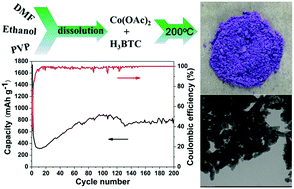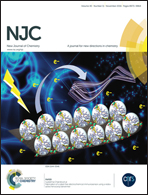Nanostructured Co(ii)-based MOFs as promising anodes for advanced lithium storage†
Abstract
A novel kind of Co-based metal–organic frameworks (MOFs) are firstly prepared by coordination assembly of Co(II) and 1,3,5-benzenetricarboxylic acid (H3BTC) through a hydrothermal route (referred to as Co-BTC MOF). Such Co-BTC MOF have a zigzag vermicular-like shape with a length of 126 nm and a width of 55 nm. Co-BTC MOFs without calcination treatment are applied as anode materials for lithium-ion batteries (LIBs) and show superior electrochemical performance, including high lithium storage capacity (1739 mA h g−1 in the first discharge process at a current density of 100 mA g−1), excellent coulombic efficiency (above 99% in the 199th cycle) and cycling performance (>750 mA h g−1 over 200 cycles) in the potential range of 0.01–3.0 V vs. Li/Li+. Such excellent electrochemical performance may be derived from the conjugated carboxylate moiety and the linker structure. More importantly, the facile approach may also be extended to other metal-based MOFs and the intriguing results show that nano-sized MOFs will be regarded as futuristic anode materials for advanced lithium storage.


 Please wait while we load your content...
Please wait while we load your content...